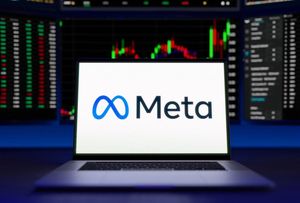
The global semiconductor industry has been a hotbed of extreme stock volatility between 2023 and 2025, driven by an unprecedented confluence of factors including the artificial intelligence (AI) boom, dynamic supply chain shifts, and escalating geopolitical tensions. While established giants like Nvidia and TSMC have seen their valuations soar and dip dramatically, smaller players like India's RRP Semiconductor Limited (BSE: RRP; NSE: RRPSEM) have also experienced parabolic growth, highlighting the speculative fervor and strategic importance of this critical sector. This period has not only reshaped market capitalization but has also prompted significant regulatory interventions, particularly from the United States, aimed at securing technological leadership and supply chain resilience.
The rapid fluctuations underscore the semiconductor industry's pivotal role in the modern economy, acting as the foundational technology for everything from consumer electronics to advanced AI systems and defense applications. The dramatic swings in stock prices reflect both the immense opportunities presented by emerging technologies like generative AI and the profound risks associated with global economic uncertainty and a fragmented geopolitical landscape. As nations vie for technological supremacy, the semiconductor market has become a battleground, with direct implications for corporate strategies, national security, and global trade.
Unpacking the Technical Tides and Market Swings
The period from 2023 to 2025 has been characterized by a complex interplay of technological advancements and market corrections within the semiconductor space. The Morningstar Global Semiconductors Index surged approximately 161% from May 2023 through January 2025, only to experience a sharp 17% decline within two months, before rebounding strongly in the summer of 2025. This roller-coaster ride is indicative of the speculative nature surrounding AI-driven demand and the underlying supply-side challenges.
At the heart of this volatility are the cutting-edge advancements in Graphics Processing Units (GPUs) and specialized AI accelerators. Companies like Nvidia Corporation (NASDAQ: NVDA) have been central to the AI revolution, with its GPUs becoming the de facto standard for training large language models. Nvidia's stock experienced phenomenal growth, at one point making it one of the world's most valuable companies, yet it also faced significant single-day losses, such as a 17% drop (USD 590 billion) on January 27, 2025, following the announcement of a new Chinese generative AI model, DeepSeek. This illustrates how rapidly market sentiment can shift in response to competitive developments. Taiwan Semiconductor Manufacturing Company Limited (NYSE: TSM), as the dominant foundry for advanced chips, also saw its stock gain nearly 85% from February 2024 to February 2025, riding the AI wave but remaining vulnerable to geopolitical tensions and supply chain disruptions.
The technical differences from previous market cycles are profound. Unlike past boom-bust cycles driven by PC or smartphone demand, the current surge is fueled by AI, which requires vastly more sophisticated and power-efficient chips, pushing the boundaries of Moore's Law. This has led to a concentration of demand for specific high-end chips and a greater reliance on a few advanced foundries. While companies like Broadcom Inc. (NASDAQ: AVGO) also saw significant gains, others with industrial exposure, such as Texas Instruments Incorporated (NASDAQ: TXN) and Analog Devices, Inc. (NASDAQ: ADI), experienced a severe downturn in 2023 and 2024 due to inventory corrections from over-ordering during the earlier global chip shortage. The AI research community and industry experts have largely welcomed the innovation but expressed concerns about the sustainability of growth and the potential for market overcorrection, especially given the intense capital expenditure required for advanced fabrication.
Competitive Implications and Market Repositioning
The extreme volatility and regulatory shifts have profound implications for AI companies, tech giants, and startups alike. Companies that control advanced chip design and manufacturing, like Nvidia and TSMC, stand to benefit immensely from the sustained demand for AI hardware. Nvidia's strategic advantage in AI GPUs has solidified its position, while TSMC's role as the primary fabricator of these advanced chips makes it indispensable, albeit with heightened geopolitical risks. Conversely, companies heavily reliant on these advanced chips face potential supply constraints and increased costs, impacting their ability to scale AI operations.
The competitive landscape for major AI labs and tech companies is intensely affected. Access to cutting-edge semiconductors is now a strategic imperative, driving tech giants like Google, Amazon, and Microsoft to invest heavily in custom AI chip development and secure long-term supply agreements. This vertical integration aims to reduce reliance on external suppliers and optimize hardware for their specific AI workloads. For startups, securing access to scarce high-performance chips can be a significant barrier to entry, potentially consolidating power among larger, more established players.
Potential disruption to existing products and services is also evident. Companies unable to adapt to the latest chip technologies or secure sufficient supply may find their AI models and services falling behind competitors. This creates a powerful incentive for innovation but also a risk of obsolescence. Market positioning and strategic advantages are increasingly defined by control over the semiconductor value chain, from design and intellectual property to manufacturing and packaging. The drive for domestic chip production, spurred by government initiatives, is also reshaping supply chains, creating new opportunities for regional players and potentially diversifying the global manufacturing footprint away from its current concentration in East Asia.
Wider Significance in the AI Landscape
The semiconductor sector's volatility and the subsequent regulatory responses are deeply intertwined with the broader AI landscape and global technological trends. This period marks a critical phase where AI transitions from a niche research area to a fundamental driver of economic growth and national power. The ability to design, manufacture, and deploy advanced AI chips is now recognized as a cornerstone of national security and economic competitiveness. The impacts extend beyond the tech industry, influencing geopolitical relations, trade policies, and even military capabilities.
Potential concerns are manifold. The concentration of advanced chip manufacturing in a few regions, particularly Taiwan, poses significant geopolitical risks. Any disruption due to conflict or natural disaster could cripple global technology supply chains, with devastating economic consequences. Furthermore, the escalating "chip war" between the U.S. and China raises fears of technological balkanization, where different standards and supply chains emerge, hindering global innovation and cooperation. The U.S. export controls on China, which have been progressively tightened since October 2022 and expanded in November 2024 and January 2025, aim to curb China's access to advanced computing chips and AI model weights, effectively slowing its AI development.
Comparisons to previous AI milestones reveal a shift in focus from software algorithms to the underlying hardware infrastructure. While early AI breakthroughs were often about novel algorithms, the current era emphasizes the sheer computational power required to train and deploy sophisticated models. This makes semiconductor advancements not just enabling but central to the progress of AI itself. The CHIPS Act in the U.S., with its substantial $348 billion investment, and similar initiatives globally, underscore the recognition that domestic chip manufacturing is a strategic imperative, akin to previous national efforts in space exploration or nuclear technology.
Charting Future Developments
Looking ahead, the semiconductor industry is poised for continued rapid evolution, albeit within an increasingly complex geopolitical framework. Near-term developments are expected to focus on further advancements in chip architecture, particularly for AI acceleration, and the ongoing diversification of supply chains. We can anticipate more localized manufacturing hubs emerging in the U.S. and Europe, driven by government incentives and the imperative for resilience. The integration of advanced packaging technologies and heterogeneous computing will also become more prevalent, allowing for greater performance and efficiency.
In the long term, potential applications and use cases on the horizon include pervasive AI in edge devices, autonomous systems, and advanced scientific computing. The demand for specialized AI chips will only intensify as AI permeates every aspect of society. Challenges that need to be addressed include the immense capital costs of building and operating advanced fabs, the scarcity of skilled labor, and the environmental impact of chip manufacturing. The geopolitical tensions are unlikely to abate, meaning companies will need to navigate an increasingly fragmented global market with varying regulatory requirements.
Experts predict a bifurcated future: one where innovation continues at a breakneck pace, driven by fierce competition and demand for AI, and another where national security concerns dictate trade policies and supply chain structures. The delicate balance between fostering open innovation and protecting national interests will be a defining feature of the coming years. What experts universally agree on is that semiconductors will remain at the heart of technological progress, making their stability and accessibility paramount for global advancement.
A Critical Juncture for Global Technology
The period of extreme stock volatility in semiconductor companies, exemplified by the meteoric rise of RRP Semiconductor Limited and the dramatic swings of industry titans, marks a critical juncture in AI history. It underscores the profound economic and strategic importance of semiconductor technology in the age of artificial intelligence. The subsequent regulatory responses, particularly from the U.S. government, highlight a global shift towards securing technological sovereignty and de-risking supply chains, often at the expense of previously integrated global markets.
The key takeaways from this tumultuous period are clear: the AI boom has created unprecedented demand for advanced chips, leading to significant market opportunities but also intense speculative behavior. Geopolitical tensions have transformed semiconductors into a strategic commodity, prompting governments to intervene with export controls, subsidies, and calls for domestic manufacturing. The significance of this development in AI history cannot be overstated; it signifies that the future of AI is not just about algorithms but equally about the hardware that powers them, and the geopolitical struggles over who controls that hardware.
What to watch for in the coming weeks and months includes the effectiveness of new regulatory frameworks (like the U.S. export controls effective April 1, 2025), the progress of new fab constructions in the U.S. and Europe, and how semiconductor companies adapt their global strategies to navigate a more fragmented and politically charged landscape. The ongoing interplay between technological innovation, market dynamics, and government policy will continue to shape the trajectory of the semiconductor industry and, by extension, the entire AI-driven future.
This content is intended for informational purposes only and represents analysis of current AI developments.
TokenRing AI delivers enterprise-grade solutions for multi-agent AI workflow orchestration, AI-powered development tools, and seamless remote collaboration platforms.
For more information, visit https://www.tokenring.ai/.





